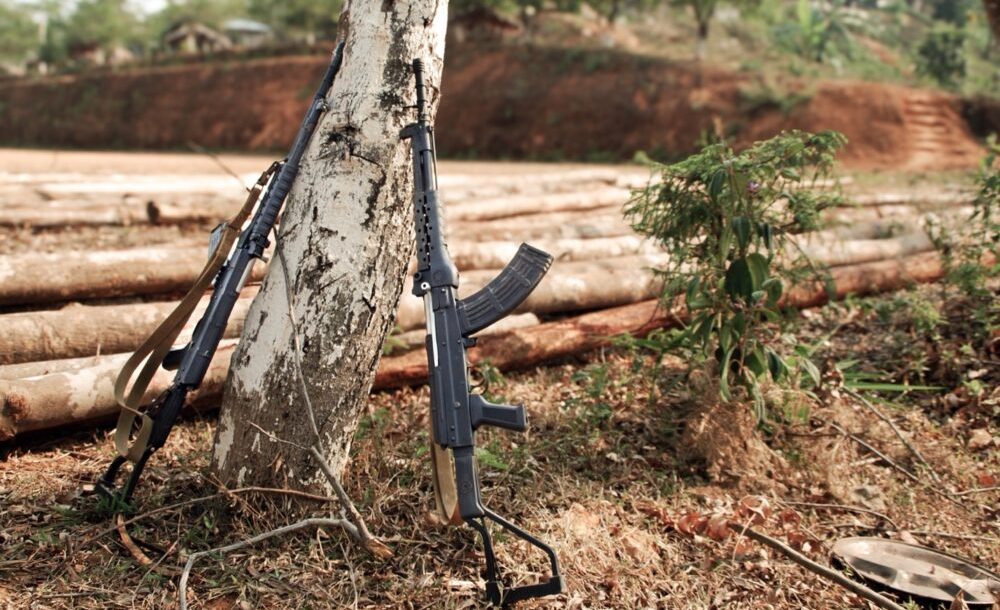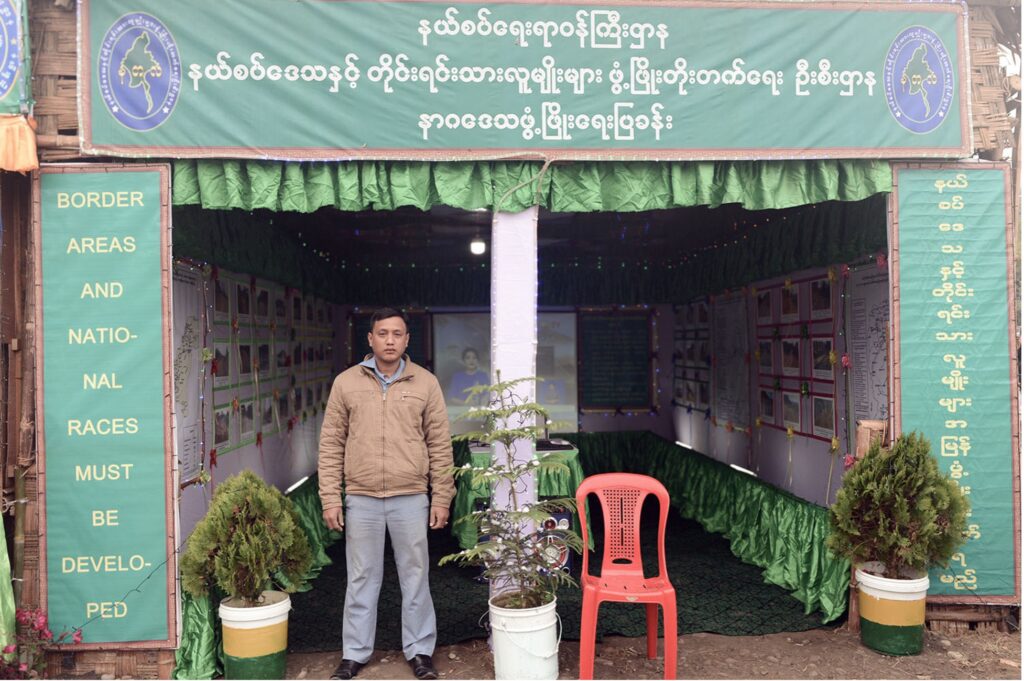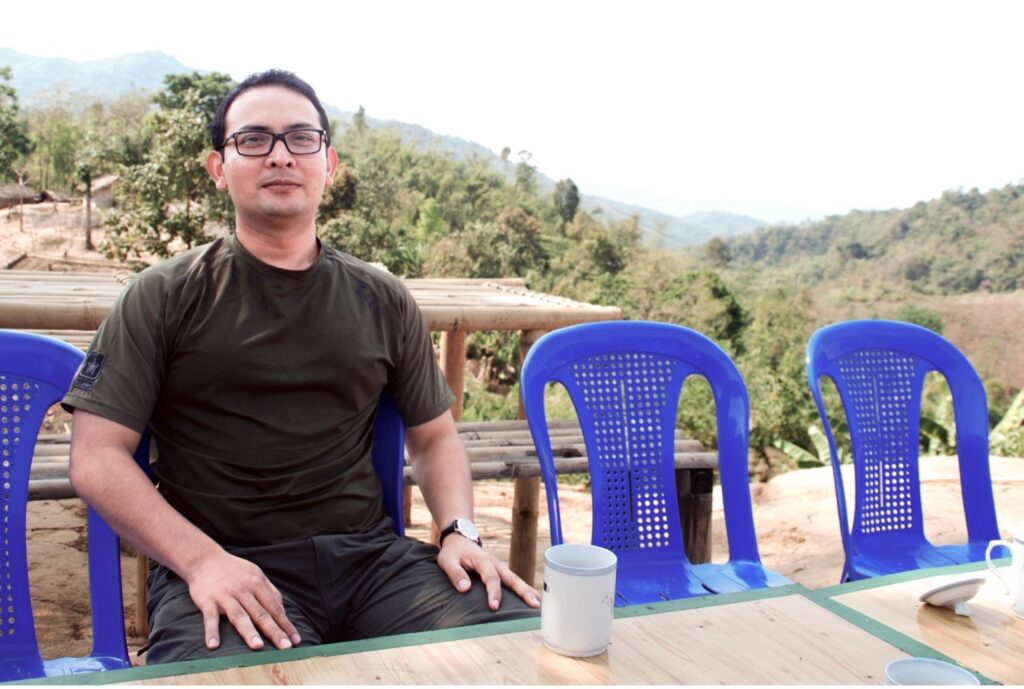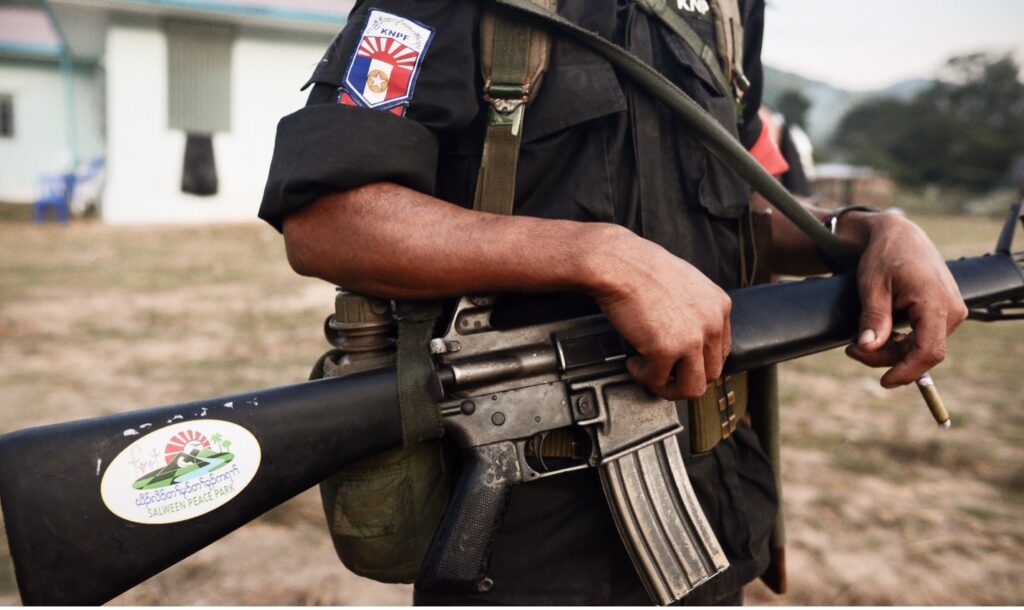Ethnonationalism and Myanmar’s future
The crisis in Myanmar is a fundamental struggle over the identity and structure of the nation-state. Underpinning this conflict are ethnonational politics that are driving war but also create avenues for peace.

A camp of the Kachin Independence Army, April 2014. Photo: David Brenner.
David Brenner - 18 Sep, 2024
Observers in the West have largely interpreted the devastating violence that has engulfed Myanmar following the February 2021 military coup as a “battle between democracy and authoritarianism”. This understanding has become commonplace amongst journalists, researchers, and policymakers describing the conflict. The struggle for democracy has indeed long served as the main analytical lens through which Myanmar’s troubled politics are interpreted in Washington, London, Brussels and Canberra. This emphasis on Myanmar’s political system, however, fails to account for the root causes and key dynamics of the crisis. The crisis is not merely a clash over governance models, but a fundamental struggle over the identity and structure of the nation-state itself.
More problematically, the “lens of democracy” renders these root causes of conflict invisible. It does so by viewing the nation-state as the natural form of political organising. But state formation in Myanmar has remained highly contested. It has also become inseparable from violence along ethnic lines: in a region where colonial modernity has imprinted questions of ethnicity into the trajectory of state-making, ethnonational politics shape Myanmar’s current crisis in a profound way. Shifting our focus to such ethnonational politics is therefore key to understanding the main drivers of the conflict, and by extension, how policy can support a more peaceful future in the country.
Rethinking the drivers of war
The biggest challenge to peace in Myanmar is the country’s military and its attempt to terrorise the population into submission. But while the generals are chiefly responsible for dragging the country towards the abyss, there is a need to reckon with the underlying structural features of Myanmar’s state, which have haunted the country since British colonial rule. Since an attempt to negotiate power between ethnic groups failed at the eve of independence in 1947, the state has not been able to address ethnic minority grievances or forge a unified national identity.
Ethnonational conflict has also long been exacerbated by the country’s leaders, who have sowed ethnic division and violence for decades. The military has maintained its longstanding stranglehold over the country precisely because generals have used the threat of ethnic separatism to portray themselves as the “guardians of the nation”. These generals have turned Myanmar into an ethnocratic state that discriminates against ethnic minorities, or ethnic nationalities, who make up about 40% of the population. Ethnic conflict has consequently remained a defining feature of the postcolonial state.

The military-controlled Ministry of Border Affairs in the Naga-Self Administered Zone, Nanyun, January 2018 (Photo: David Brenner)
Many ethnic nationalities have resisted institutional discrimination for decades, including by taking up arms against the central state. The military has responded with waging war against them, painting them as internal enemies of the nation. This strategy has become the military’s key means of state making, and it is why the military has long fuelled ethnic tensions with divide-and rule tactics. It continues to do so in the current war with devastating consequences. As a result of the military’s divisive tactics, a multitude of ethnonational rebel movements, known as Ethnic Armed Organisations (EAOs), have mobilised across the country. In addition to fighting for more autonomy for their respective constituents, EAOs have built de facto states within the state in territories that have never been exclusively controlled by the military.
EAOs have played a critical role in the current countrywide armed mobilisation, including the formation of People’s Defence Forces (PDFs) that have taken up arms against the junta. Some EAOs, such as those of the Karen, Chin, Karenni, and Kachin, aligned themselves with the Spring Revolution early on and have sheltered, trained, and organised armed resistance units on a large scale. But even EAOs who have kept a distance from the countrywide campaign for democracy, such as the Ta’ang, Kokang, Arakan, and Wa movements, have proven instrumental in the armed uprising across Myanmar. Their non-state territories and guerrilla logistics have helped to scale up the military capabilities of armed opposition forces countrywide.
The rapid unravelling of military control over large swathes of territory, including urban centres in the country’s borderlands since late 2023, is a direct consequence of unprecedented EAO offensives. Yet despite their recent coordination, EAOs follow different strategies. Indeed, the aforementioned escalation was spearheaded by EAOs that have remained sceptical about the Spring Revolution. Notwithstanding their positioning on the revolution, the main concern of all EAOs remains autonomy for their ethnic constituents. The key difference is that some EAOs seek to achieve this autonomy in closer cooperation with the countrywide revolution for federal democracy, while others seek to achieve it more independently.

AA commander Twan Mrat Naing in the group’s temporary Kachin State headquarters, March 2014 (Photo: David Brenner)
Twan Mrat Naing, commander of the Arakan Army (AA), one of the most powerful EAOs in the country, illuminated the latter position to journalists in 2022. Explaining why his movement did not join hands with the Spring Revolution after the coup he stated, “Our main objective is ‘Rakhita,’ to win back our lost sovereignty. The previous generations in Arakan wasted a lot of time in following and supporting the Burmese … Arakan was even involved in the 1988 movement to restore democracy, but failed to reap any benefits.” He continued, “After such experiences, we no longer want to follow the Burmese. We want to work towards our own objectives. It is our strategic position to remain at a distance from the ongoing struggle for democracy now in Burma.”
Importantly, though, these positions are not fixed, and continue to evolve with the rapidly developing situation. This is why EAOs cannot easily be divided into two camps. The Ta’ang National Liberation Army, for instance, voiced strong concerns against a closer alliance with the opposition National Unity Government (NUG) in late 2022. Since then, it has rapidly developed alliances with NUG-affiliated PDFs. The movement currently seeks to cooperate with the Civil Disobedience Movement (CDM) to restore public services in the territory that it has captured in its offensives since last October. In a recent interview, the AA’s Twan Mrat Naing explained how evolving relations with other resistance forces has also shaped his outlook over the past two years. He stressed the need for building more alliances and partnerships and adopting a “holistic view that accounts for the entire union and our surrounding environment.” In his perspective, this is not inconsistent with “the confederation that Rakhine has been advocating” (rather than a federal union).
Finding avenues for peace
Ethnonational politics in Myanmar are not only a force of war—they have also long worked as one of the main determinants of local stability. As the state has never exclusively governed its territory, EAOs have been operating non-state administration for decades. These alternative political orders are especially sophisticated in Myanmar’s borderlands with China and Thailand, where organisations such as the Karen National Union (KNU) and the Kachin Independence Organisation (KIO) have long remained influential governance actors. Their administrations are instrumental in delivering health and education to hundreds of thousands of conflict-affected people. They have also become important international partners, as demonstrated by their crucial role in humanitarian relief aid, refugee protection, and regional pandemic responses.

A nurse prepares an anaesthetic in the KIO-operated hospital of Laiza. March 2014 (Photo: David Brenner)
Mainstream accounts in the literature on “rebel governance” fail to adequately capture the diverse functions of EAO administrations. EAO governance is not only an instrumental means to power, with which rebel groups deliver public services in return for local support and legitimacy. A purely regulative perspective that highlights the maintenance of public order is also insufficient. Rather, EAO governance is primarily about fostering national sovereignty in ethnic nationality communities. Put differently, EAO governance is about nation-building.
What does this mean for Myanmar’s future and potential avenues for peace? At a time when multiple EAOs are drastically expanding their territories, their governance apparatuses and nation-building ambitions are expanding, too. While most such claims precede the military coup, they have become more sensitive with the rapid expansion of EAOs. This presents an increased risk of inter-EAO conflict over territorial claims. (That said, northern Shan State, a place where inter-EAO relations have long been tense, also showcases that EAOs are mostly pragmatic in addressing such conflict with each other.)
Related

Revolution and solidarity in Myanmar
On the end of the “transition paradigm” and the meanings of the present revolution
Justine Chambers & Nick Cheesman 09 September, 2024
More pressing are issues of inclusivity and accountability. EAOs govern over ethnically heterogeneous populations, and this heterogeneity has only increased with their current territorial gains. This becomes particularly worrisome in regions where communal conflict predates the current crisis. For instance, reports of the AA’s attacks on Rohingya communities, its inflammatory anti-Rohingya rhetoric, and intimidation of civil society rightfully raise alarm bells. However, we must not tar all EAOs with the same brush. EAOs are hugely diverse organisations, with a vast variety of ideological leanings, historical experiences, internal governance mechanisms, and material conditions.
Some EAOs have produced more accountable and inclusive relations with local communities than others. The KNU and the KIO, for instance, have a long tradition of engaging with civil society actors. These actors have played an important role in spearheading new forms of accountable governance, such as in the case of the Salween Peace Park, a land rights and conservation project led by Karen activists in collaboration with the KNU. The KNU and KIO also operate extensive non-state education systems that support ethnic diversity. While their curricula stresses mother-tongue based education, they both strive for more inclusivity in their education systems that partly operate in heterogeneous communities. The KIO has, for instance, just announced its support for other ethnic and religious groups setting up private schools in its territory.
Some EAOs have produced more accountable and inclusive relations with local communities than others. The KNU and the KIO, for instance, have a long tradition of engaging with civil society actors. These actors have played an important role in spearheading new forms of accountable governance, such as in the case of the Salween Peace Park, a land rights and conservation project led by Karen activists in collaboration with the KNU. The KNU and KIO also operate extensive non-state education systems that support ethnic diversity. While their curricula stresses mother-tongue based education, they both strive for more inclusivity in their education systems that partly operate in heterogeneous communities. The KIO has, for instance, just announced its support for other ethnic and religious groups setting up private schools in its territory.

A Karen National Police Force member of the KNU at the Salween Peace Park opening in Mutraw, December 2019 (Photo: David Brenner)
None of this is perfect, and how could it be, in the context of a decades-long war? But it clearly suggests promising possibilities for a more peaceful future. The key to such a future is bolstering initiatives that support inclusive and accountable EAO governance. Rather than shun all EAOs because of the actions of individual armed groups, donors and development agencies should step up their engagement with these groups, who will only grow in their role as governance actors in Myanmar. Similarly, as US policymakers seek to step up their support for Myanmar, the newfound Congressional Burma Caucus should work with rather than against the grain of EAO governance. Concretely, this means partnering with EAOs beyond humanitarian aid relief.
US lawmakers and government agencies should follow through on the pledges outlined in the BURMA Act of 2022 and step up the provision of non-lethal support for resistance actors in Myanmar. Other donors should do the same. Part of this aid should be used for supporting EAO governance in areas that foster cooperation and stability, such as education, health, justice, and land rights. To do so, donors should seek the partnership of local civil society actors from diverse ethnic nationality communities for this endeavour. These actors are key to ensuring that support goes to initiatives that strengthen inclusive and accountable forms of governance. This targeted approach to support is the best way to incentivise all EAOs to adopt governance practices that promote inclusivity and accountability, carving a sustainable path to peace in Myanmar.
Working with EAO governance can in turn serve as a useful impetus for rethinking international interventions in conflict-affected contexts more generally. To be sure, calling for closer engagement with local governance actors is nothing new in and of itself. On the contrary, the “local turn” has become the mainstay of critical peacebuilding research and practice. The bulk of this work, however, remains wedded to Eurocentric understandings of the state and “the local”—or at least those local actors whose politics are deemed worthy of support.
Unsurprisingly, ethnonational armed movements have hitherto not been viewed as local peacebuilding partners. And while we must not romanticise exclusionary tendencies of ethnonationalist ideologies, we need to contextualise them within the postcolonial politics of ethnocratic state formation in a context like Myanmar. Doing so produces a more differentiated understanding of the drivers of conflict and suggests new avenues for peace.
Author’s note: I am grateful to Jenna Marcus for her helpful feedback.
New Mandala
About the Author

David Brenner
David Brenner is Senior Lecturer in Global Insecurities at the University of Sussex. He has researched ethnonational politics and EAOs in Myanmar since 2012, including for his PhD at the London School of Economics. He has published widely on the matter and is author of "Rebel Politics: A Political Sociology of Armed Struggle in Myanmar’s Borderlands" (Cornell University Press, 2019).
David Brenner is Senior Lecturer in Global Insecurities at the University of Sussex. He has researched ethnonational politics and EAOs in Myanmar since 2012, including for his PhD at the London School of Economics. He has published widely on the matter and is author of "Rebel Politics: A Political Sociology of Armed Struggle in Myanmar’s Borderlands" (Cornell University Press, 2019).
No comments:
Post a Comment